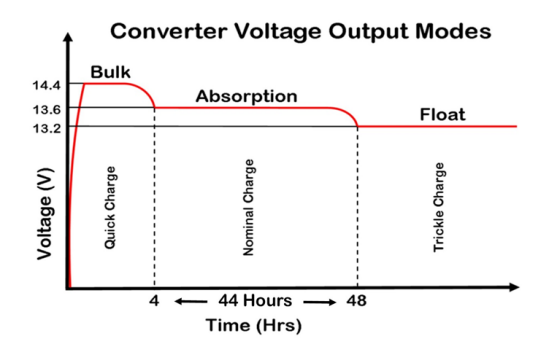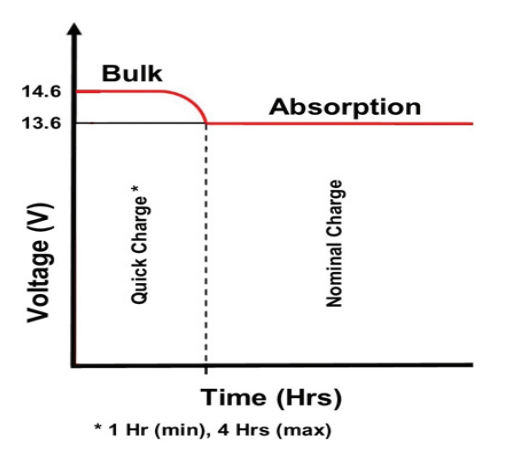
 |
Moving Lithium batteries to under bench seat |
Post Reply 
|
Page 12> |
| Author | |
BTRice 
Newbie 
Joined: 16 Nov 2021 Online Status: Offline Posts: 7 |
 Post Options Post Options
 Quote Quote  Reply Reply
 Topic: Moving Lithium batteries to under bench seat Topic: Moving Lithium batteries to under bench seatPosted: 25 Apr 2022 at 6:19pm |
|
So. I recently added two lithium batteries and an inverter to my RPOD. Now that I’ve put in that work, I’m moving the batteries to the area under the set where the converter is. Does anyone have a wiring diagram for a 2018 180? I’d like to trace the positive and negative wires before I get under the chassis. If not, I’ll just do it the old fashion way.
Thanks! |
|
 |
|
RoverPod 
Senior Member 

Joined: 07 Mar 2020 Location: Virginia Online Status: Offline Posts: 118 |
 Post Options Post Options
 Quote Quote  Reply Reply
 Posted: 25 Apr 2022 at 8:09pm Posted: 25 Apr 2022 at 8:09pm |
|
There are no wiring diagrams for any rPods. And the arrangement of any one rPod's wiring is likely different from any other rPod depending on how the crew built it that particular day. Good luck with your project. I'm interested in seeing how it turns out.
|
|
|
2017 F150 XLT SuperCab
2020 rPod 180 |
|
 |
|
BTRice 
Newbie 
Joined: 16 Nov 2021 Online Status: Offline Posts: 7 |
 Post Options Post Options
 Quote Quote  Reply Reply
 Posted: 25 Apr 2022 at 8:47pm Posted: 25 Apr 2022 at 8:47pm |
|
Thanks. I’ll post pics when done.
|
|
|
2011 F150 XLT Super Crew
2018 RPOD 180 |
|
 |
|
offgrid 
Senior Member 
Joined: 23 Jul 2018 Online Status: Offline Posts: 5290 |
 Post Options Post Options
 Quote Quote  Reply Reply
 Posted: 27 Apr 2022 at 5:41pm Posted: 27 Apr 2022 at 5:41pm |
|
+1, you couldnt depend on a wiring diagram even if there was one. Use a multimeter and check each of the wires with the continuity setting to be sure you know what is running where.
|
|
|
1994 Chinook Concourse
1995 RV6A Experimental Aircraft 2015 Rpod 179 - sold |
|
 |
|
BTRice 
Newbie 
Joined: 16 Nov 2021 Online Status: Offline Posts: 7 |
 Post Options Post Options
 Quote Quote  Reply Reply
 Posted: 27 Apr 2022 at 7:23pm Posted: 27 Apr 2022 at 7:23pm |
|
Thanks
|
|
|
2011 F150 XLT Super Crew
2018 RPOD 180 |
|
 |
|
Ibcj 
Newbie 
Joined: 01 Sep 2021 Location: CA Online Status: Offline Posts: 5 |
 Post Options Post Options
 Quote Quote  Reply Reply
 Posted: 27 May 2022 at 3:20pm Posted: 27 May 2022 at 3:20pm |
|
BTRice: how did this turn out? I'm in the process of ordering a LiFePO4 battery for my 2021 193 that I'm planning to (try to) put under the front bench. Based on my experience with my rpod build quality, I'm NOT looking forward to the rat's nest of wiring I expect to find.
Did you replace the converter as well? Mine came with a 2020 WF-8735P that I'm contemplating swapping out with a WF-8735AD to get the Lithium friendly two-stage charging option. Open to thoughts from the peanut gallery too! (I've been lurking and found offgrid's comments and suggestions especially helpful already!)
|
|
 |
|
BTRice 
Newbie 
Joined: 16 Nov 2021 Online Status: Offline Posts: 7 |
 Post Options Post Options
 Quote Quote  Reply Reply
 Posted: 27 May 2022 at 5:05pm Posted: 27 May 2022 at 5:05pm |
|
I did replace the converter to the AD and also installed an inverter in the exterior storage compartment behind the door. Haven’t moved the batteries yet. That’s on my list of things to do.
|
|
|
2011 F150 XLT Super Crew
2018 RPOD 180 |
|
 |
|
offgrid 
Senior Member 
Joined: 23 Jul 2018 Online Status: Offline Posts: 5290 |
 Post Options Post Options
 Quote Quote  Reply Reply
 Posted: 27 May 2022 at 8:01pm Posted: 27 May 2022 at 8:01pm |
|
You do want to install a converter configured for Li battery charging. There is too much risk from overcharging Li batteries. Placing them in a temperature regulated space is a good idea, Li batteries don't like to be charged at low (below freezing) temps.There are now self heating Li batteries available now but why waste energy?
The issue regarding charge profile for Li batteries applies to all your charge sources, including solar and tow vehicle charging if you plan to use those. Most solar charge controllers these days have a Li setting, but proper charging from an alternator/TV battery requires installation of a DC DC converter. That should connect directly to the tow vehicle 12V charge conductor as exits the 7 way connector, and no trailer circuits should be connected directly to the TV 12V supply before the DC DC converter, with the exception of the turn signals, marker, tail, and brake lights, which are never connected to the trailer battery. The interesting execption to this is the electric trailer brakes, which are normally supplied from the TV battery via the brake controller, unless the brakeaway pin is pulled in which case they switch over to the trailer battery. This circuit shouldn't need any modification when converting to Li, just thought I'd mention it because of it's unique status. |
|
|
1994 Chinook Concourse
1995 RV6A Experimental Aircraft 2015 Rpod 179 - sold |
|
 |
|
Ibcj 
Newbie 
Joined: 01 Sep 2021 Location: CA Online Status: Offline Posts: 5 |
 Post Options Post Options
 Quote Quote  Reply Reply
 Posted: 27 May 2022 at 11:14pm Posted: 27 May 2022 at 11:14pm |
|
Super helpful, thanks to you both for your quick responses here.
I looked at the charging profiles for both the WF-8735P and WF-8735AD and the three-stage profile is the same on both. It seems that this would be safe for a Li battery, just not optimal, which would allow me to safely run the WF-8735P with the Li battery. Here's what I'm basing this on:   More in the AD manual here. There are a couple board posts that have mentioned the WFCO units (I presume the P units, not the dual AD units) that have fried batteries by, presumably, the charge controller going haywire. There was a post that mentioned swapping out the charge controller board in the WFCO with something from Progressive Dynamics, but I haven't chased that down fully yet. Seems the easiest path is to just replace the WF-8735P with the WF-8735AD and for the minimal extra cost, get some modicum of safety knowing it is using the two-stage charging for Li. Any suggestions are welcomed! I'm also assuming to get access to this wiring I should start by dropping the bottom corrugated plastic board from the r-pod - something I haven't done yet. I've pulled out the WF-8735P once, and that visual gave me hives. offgrid: I have purchased a DC-to-DC charger. I went with 20A, which assuming that is the output current, should keep me safely under the 30A that I can pull through the 7-wire. I also have a Renogy 100W suitcase solar charger that has a Li mode on the charge controller, so I feel comfortable there. Interesting about the brake trailer controller circuit switch when the pin is pulled, I always wondered about that. Hopefully there are no assembly gremlins around the 7-pin pigtail on the TT and I don't have to monkey with that. But given that I found out today that the output side of my fresh water pump has been leaking from the fitting that was never tightened, I'm not optimistic that I won't find more gremlins in the wiring.
 |
|
|
2021 r-pod 193
|
|
 |
|
offgrid 
Senior Member 
Joined: 23 Jul 2018 Online Status: Offline Posts: 5290 |
 Post Options Post Options
 Quote Quote  Reply Reply
 Posted: 28 May 2022 at 4:18am Posted: 28 May 2022 at 4:18am |
|
Generally speaking, Li batteries don't need a multistage charging profile, unlike lead acid batteries. PbA batts do because their internal resistance increases dramatically as they near full charge, so you have to taper the current to get them there. They also need a small continuous (or at least frequent) float charge current or they will self discharge and the individual battery cells will become imbalanced. The continuous float charge corrects this by slightly overcharging some cells, allowing the others to get to full charge. Finally flooded PbA's need an occasional equalization charge at a highrr voltage to mix the electrolyte, which tends to stratify (sulfuric acid is heavier than water) otherwise. Simply put PbAs both tolerate and need some overcharging to perform properly and last.
OTOH, Li batteries can simply be charged up to a set voltage and stopped unless you are trying to recharge them at a very high rate (like in an EV fast charge station). It is harmful/dangerous to charge Li batts higher than that. That means a different approach has to be taken to assure cell to cell balance another approach is needed. This is an electronic cell balancer which should come integrated into any Li battery you buy. These usually (but not always) also come with a high voltage cutoff to prevent overcharging in the event your charger malfunctions. Some also monitor battery temp and limit charging when the battery is too cold. So simply put Li batteries don't tolerate or need overcharging. I'd suggest that you let the charging revommendations spec'd by your battery supplier set the direction you take for the charger(s) you get. Re WFCO, I am one who has had my lead acid batteries overcharged by a failed charger. Mine went to around 16-16.5V and stayed there. Luckily I had flooded golf cart batteries, happened to hear and smell my batteries overcharging, found my battery plates to be nearly exposed, and added water in time so no harm done, but it couldn't have been more than a week since I'd last looked. If those had been Li batteries without internal over voltage protection they would almost certainly have been destroyed or caught fire. So I don't trust WFCO chargers personally, and I also wouldn't install Li batteries inside the trailer unless they were internally protected. Too much fire risk for me. I think a 20A DC/DC is fine. Note though that it will continue to try to charge your trailer batteries even after you shut off the TV, unless you disconnect the 7 way or add a relay energized by the TV ignition circuit to automatically disconnect for you. Stopping for a few minutes to fuel up will be fine but if you stop for an hour or two or longer on the road I'd be sure to disconnect. Disconnect or cut the +12V conductor on the trailer side of the 7 way before it connects to anything else and run that to your positive DC/DC input. Then run the dcdc + output to the trailer side of the line you disconnected and you should be fine. |
|
|
1994 Chinook Concourse
1995 RV6A Experimental Aircraft 2015 Rpod 179 - sold |
|
 |
|
Post Reply 
|
Page 12> |
| Forum Jump | Forum Permissions  You cannot post new topics in this forum You cannot reply to topics in this forum You cannot delete your posts in this forum You cannot edit your posts in this forum You cannot create polls in this forum You cannot vote in polls in this forum |